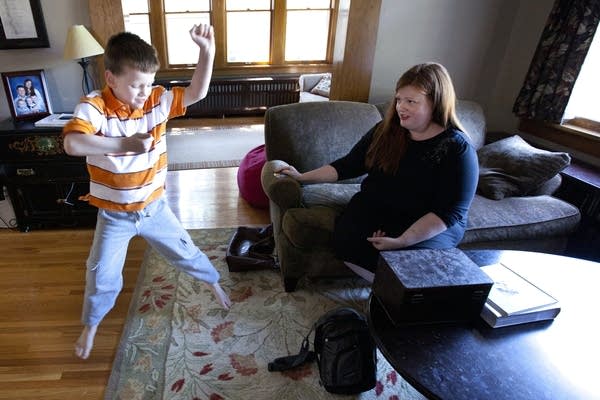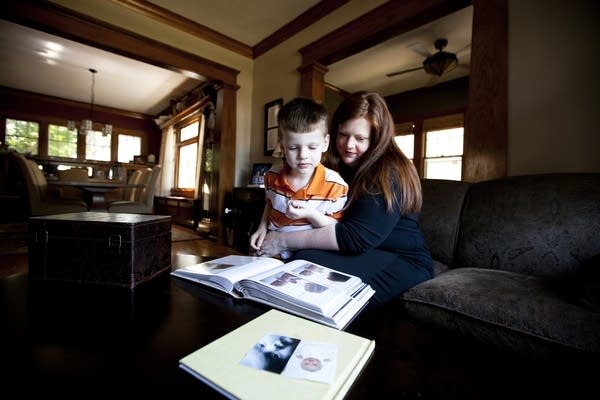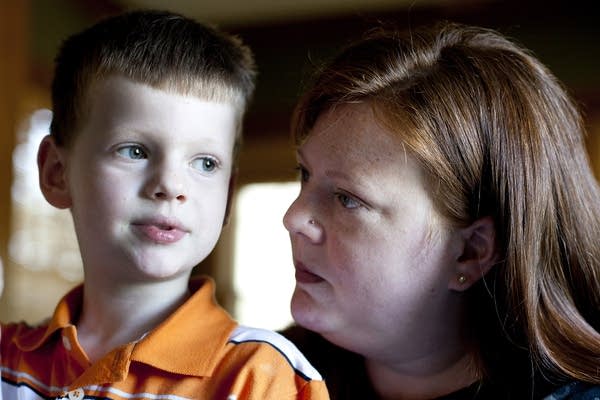Minnesota's infant death investigations inconsistent, unregulated

As Colleen Lindstrom drove through Minneapolis to pick up her baby daughter from daycare in July 2005, she noticed a police car ahead of her. It stayed there the whole trip, forming an ominous motorcade that ended in front of the daycare building. A fire truck was parked outside.
Inside was three-month-old Brady, a giggly, alert little girl, and the first daughter of Colleen and Matt Lindstrom. Colleen rushed to the front door. The manager greeted her. Colleen looked down and saw her baby's empty car seat on the ground. Brady, the manager said, was dead.
Her daughter was taking a nap when she stopped breathing, everyone said. Colleen assumed it was a classic case of Sudden Infant Death Syndrome and that nothing could've prevented it. But a few weeks later, the family learned what really happened. Brady had accidentally suffocated because daycare workers placed her to sleep on her stomach. "A mistake was made that cost us our child," Lindstrom said.
Fourteen months earlier in Alexandria Minn., the infant daughter of Michael Hansen and Amanda Schulke died in a basement bedroom where she had been sleeping on a futon with her father and three-year-old sister. Her father said he woke up to find four-month-old Avryonna cold and unresponsive.
Create a More Connected Minnesota
MPR News is your trusted resource for the news you need. With your support, MPR News brings accessible, courageous journalism and authentic conversation to everyone - free of paywalls and barriers. Your gift makes a difference.
The police were suspicious. Hansen was charged with second-degree murder, convicted, and sentenced to 14 1/2 years in prison. He maintained that he did not kill his daughter, and in July a judge overturned the conviction. Last week, the Douglas County prosecutor dropped all charges.
Brady and Avryonna died less than 150 miles from each other, but their deaths received two very different investigations.
Brady's death was investigated by the Hennepin County Medical Examiner's Office, and a forensic pathologist from there performed the autopsy. Its investigators visited the daycare and used a doll to re-enact how Brady died.
Avryonna's death didn't prompt a visit from any medical examiner's office. There was no doll re-enactment. The medical examiner relied on law enforcement officials to investigate the scene. They looked for evidence of a homicide, but paid little attention to the baby's sleeping arrangements. Avryonna's body was autopsied twice - by the Douglas County medical examiner, who is not a forensic pathologist, and by Ramsey County medical examiner Michael McGee, whose office is more than 100 miles away.
McGee, a forensic pathologist, wrote the final autopsy report. He found that Avryonna died of blunt force head trauma and ruled the death a homicide. However, five doctors, including two medical examiners, who reviewed the case last year said it's more likely the baby accidentally suffocated in her sleep.

INCONSISTENT LAWS
While the contrasting approaches are clear, they are similar in one potent way.
The investigation of Brady's death followed state and national guidelines for investigating sudden, unexpected infant deaths. The investigation of Avryonna's death did not. Neither, however, was required to adhere to any particular set of guidelines.
That's because there are no state or federal laws that require Minnesota medical examiners or coroners to follow even the most basic guidelines for investigating infant deaths. And what guidelines exist are routinely ignored by counties. Moreover, supervision of medical examiners and coroners is lacking in Minnesota along with any reliable process to track infant deaths.
The inconsistencies, say state and national experts in child death investigations, have resulted in a patchwork system where crimes go undiscovered, innocent parents are charged with homicide, rare genetic diseases go undetected, and public health officials do not have accurate data to prevent accidental deaths.
"We are not only missing cases, sometimes we're over calling them, and we're putting people in prison for things that they didn't do," said Michael Laposata, the chief pathologist for Vanderbilt University Medical Center in Tennessee, who has helped identify rare blood disorders in children who appeared to have suffered head trauma and other child abuse.
Laposata and others say the lack of oversight makes it difficult to know how many infant deaths are improperly investigated. "My gut feeling is probably dozens," he said, although he added that his desk is covered with files from parents in prison and he has not been able to review all of them.
Medical examiners and coroners are licensed physicians, and, as with all doctors, any concerns about their work can be reported to the Minnesota Board of Medical Practice. But medical examiners are quick to point out that they're not like other doctors.
Dr. Thomas Uncini, the medical examiner for St. Louis and Koochiching counties, said doctors who treat living patients run the risk of a malpractice suit if they fail to diagnose an illness or make a mistake during surgery. But medical examiners are different. They diagnose the dead, and Uncini said it's rare for families to get a second opinion or challenge their findings. He said he's never heard of anyone filing a complaint with the Board of Medical Practice.
For the most part, Uncini and other medical examiners said, they are accountable only to themselves and the courts.

"If you look like a fool in court, hopefully you think to yourself, 'Geez, maybe we should be doing something different,'" Uncini said.
Minimal oversight is provided by the state's Child Mortality Review Panel, a group of doctors, child abuse experts, and others that review a select number of infant deaths each year. The panel looks for cases that could have a broader impact on public health, child abuse prevention, and death investigations. It can request that officials take another look at a case they believe was mishandled.
They rely on counties to report infant deaths for review, but not all counties comply with the requirement. Avryonna's death was never reported. The panel first learned of the death when contacted by MPR News.
"I don't know what happened here," said panel member Erin Sullivan Sutton, who also serves as the assistant commissioner for children and family services at the Department of Human Services.
Panel members said state guidelines on infant death investigations are rarely followed in any consistent way. The panel's reports from 2003, 2004, and 2006 raise concern about insufficient death scene investigations, inconsistent use of state guidelines, and inconsistent death classifications by medical examiners and coroners. The panel repeatedly recommended that the state update the guidelines, which were created in 1990. They were not revised until 2002.
In 2000, the panel recommended that the state's Bureau of Criminal Apprehension post the guidelines on its website so local law enforcement officials could find them. Eleven years later, they're still not posted.
DIFFERENT COUNTY, DIFFERENT INVESTIGATION
Across the state's 87 counties, infant deaths are investigated a variety of ways. Many counties have a coroner or medical examiner who may follow some guidelines and not others. Big Stone County coroner Robert Ross is a good example. He said he's never heard of any guidelines. "I guess I go by my own experience," he said. "I've been at this for 35 years." Some counties, including Hennepin, Dakota, Ramsey, Washington, Anoka and St. Louis, always send an investigator from the medical examiner's office to the death scene. Doll re-enactments are common in those counties.
But in at least 14 counties across the state, local law enforcement conduct most death scene investigations. They include rural Beltrami County and 13 counties overseen by McGee, the Ramsey County medical examiner. McGee said that he does not send investigators from the medical examiner's office to death scenes outside of Ramsey and Washington counties.
In Sherburne County, one of the counties that contracts with McGee, the sheriff's office takes photographs of the scene, but Capt. Scott Fildes said they rarely conduct doll re-enactments. "It certainly is something that we can use and would consider using," he said, "but I wouldn't say it's common, not for us, maybe for a department that has a lot more child deaths that they're investigating."

McGee said he offers training for local law enforcement on how to investigate suspicious child deaths, but it's not mandatory. "I can't sit here and tell you that every investigator from every county that we've gone to or that we work with has gone to it," he said. "I'm going to imagine the majority of them have."
Some county medical examiners and coroners said it's not possible to travel to all death scenes. In rural Beltrami County, one of the largest counties in the state -about 18 times the size of Ramsey County - law enforcement officials handle all death scene investigations. The county has just one coroner and an assistant. More complicated cases are sent to Dakota or Ramsey County for autopsy.
"We don't have the resources that the urban counties do, and we know that, and we try to act accordingly," said Lori Thompson, Beltrami County's coroner assistant.
CHALLENGING CASES
Medical examiners in Minnesota say child deaths are often the most challenging cases to investigate. Adults are supposed to die, they said. Children are not.
"When you have a two-year-old die, there's a distinct possibility that that child's been murdered," said Uncini, the medical examiner for St. Louis and Koochiching counties. "So you have to approach those deaths differently."
Adults who die often leave behind helpful clues, Uncini said, and they're usually found in the same place where they died.
In contrast, babies who die often leave behind questions, not clues. They may have suffered from an undiagnosed illness or been abused. Even the death site can be difficult to pinpoint because babies who die are almost always picked up and moved, usually by distraught caregivers.
"We're kind of the opposite of your pediatrician," said McGee, the Ramsey County medical examiner. "You take one of your kids to the doctor, and the pediatrician says, 'What's wrong?' and you give him the whole story, and so he ... has an idea of what is wrong with your child before he ever lays hands on him. We're just the opposite. You have to kind of go backwards."
Few infant deaths also make it difficult for medical examiners and coroners to gain experience and keep up their skills, particularly in smaller or less densely populated counties.

In 2009, 324 infants died in Minnesota, according to data from the Minnesota Department of Health. Statewide, only five babies died from "assault." Forty-three babies were found to have died from Sudden Infant Death Syndrome, and 11 babies died because of accidental suffocation. That year, one-third of the state's counties had zero infant deaths, and one-fourth had just one infant death.
MANY RECOMMENDATIONS, FEW RULES
In Minnesota, when a baby dies in a hospital of a disease or complications from labor, a doctor notes the cause and manner of death on the baby's death certificate. In those cases, an autopsy or investigation is rarely needed.
However, when a baby dies unexpectedly, state law requires that the death be reported to the county medical examiner or coroner for evaluation. The medical examiner or coroner determines whether to perform an autopsy or conduct any additional investigation.
There is no shortage of voluntary guidelines for how to conduct a proper infant death investigation.
The Minnesota Department of Health has a 78-page guide that includes sample forms that prompt paramedics, police, and medical examiners to fill out sections about the baby's eating habits, sleeping position, and history. It asks about the condition of the caregiver. There's even a drawing of a baby that paramedics can use to mark areas where the baby appeared injured.
The state guidelines recommend a thorough investigation and autopsy for all children under age two who die unexpectedly. It advises that every investigation should include a scene re-enactment with the person who found the baby, photographs of the scene and the re-enactment, medical records, and information from social services and law enforcement agencies that may have had contact with the family before the death.
The state guidelines are meant to create standard practices. The problem is that no one requires anyone to use them, said Mary Jo Chippendale, who supervises the woman and infant health unit at the Minnesota Department of Health.
"It's very rare that we see folks using a consistent kind of way to investigate these infant deaths," Chippendale said.
Instead, she said, "folks develop their own set of ways of doing it, or they pick and choose which of the things they want to look at." Chippendale said the lack of standards has made it difficult to compile statistics, like the number of infant deaths caused by drowning or the number of deaths due to unsafe sleeping arrangements.
"If everybody's doing things differently, you're getting lots of data, but you can't really look at it and get a handle on what it is that it's telling you," she said.
Federal guidelines, developed by the Centers for Disease Control and Prevention, include a "top 25" list of critical information for investigations of sudden, unexplained infant deaths. The list includes unsafe sleeping conditions, recent hospitalizations, prior sibling deaths, objection to autopsy, recent fall or injury, suspicious circumstances, and other items.
But Carrie Shapiro-Mendoza, who heads the CDC's work on SIDS, said there's no way to track how many counties use the guidelines or how infant deaths are investigated.
"We know there seems to be a good proportion of medical examiners and coroners offices across the country that say they do have protocols for investigating infant deaths, but what those protocols consist of, it's not clear," she said.
The National Association of Medical Examiners also has its own guidelines on what it calls the "bare minimum" to consider an infant death investigation "complete." The recommendations, issued in a 2005 report, are less detailed, but they are also voluntary.
They include a scene investigation by a medical examiner, coroner, or someone working on their behalf, the review of medical records, and the interview of witnesses.
LIMITED REVIEW
The state's Child Mortality Review Panel has repeatedly urged counties to comply with state law and report deaths.
In a September 2010 report, panel member Erin Sullivan Sutton wrote, "It has been determined that some local agencies that had child deaths or near fatalities, requiring a child protection assessment or criminal investigation, did not follow state statute. No case should be overlooked."
For the past decade, the panel has been critical of how the state handles infant death investigations. It often makes the same recommendations in each report, but has had little success convincing anyone to follow them.
A panel report published in 2003 noted, "Unfortunately, the state does not have an accurate picture of the causes of children's deaths. Nor does the state have an accurate count of children who die from abuse and neglect."
In 2004, the panel included the exact same statement. Later reports echo those concerns.
Several reports found that the state's guidelines on infant death investigations are rarely followed. "Some law enforcement officers are not aware that infant death investigation guidelines exist," a 2001 report found. "Comprehensive training on the Infant Death Investigation Guidelines has not been presented for several years."
The state's Department of Health is currently revising the guidelines, and Chippendale, of MDH, said it will ask the Bureau of Criminal Apprehension to post them on its website once they're updated. The 11-year delay in posting the guidelines was due, in part, to concerns that the information could be used by parents to cover up a crime, Sutton said.
PROSPECTS FOR REFORM
The inconsistent treatment of infant deaths should prompt Minnesota to regulate infant death investigations, said Dr. Lindsey Thomas, who serves as the medical examiner for eight counties.
"It's ridiculous that no one's in charge of any of this," she said.
Thomas wants the state's medical examiners and coroners to agree on a set of guidelines to follow, but she said it's unlikely that the group would be able to reach consensus on what guidelines, if any, should become law.
In part, she said, that's because of the tension between medical examiners and coroners, both in Minnesota and nationwide. Prominent groups, including the National Academy of Sciences, have criticized coroners, who typically are not required to have as much experience as medical examiners. In Minnesota, state law requires that coroners be physicians with active licenses, while medical examiners must be forensic pathologists.
Thomas said she hopes that medical examiners and coroners can set aside their differences to come to an agreement about child death investigations.
"That political issue shouldn't affect how a death investigation is done," she said.


